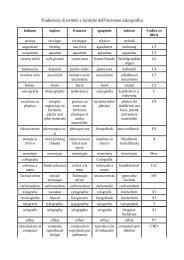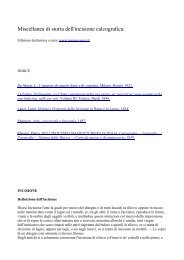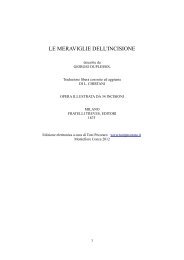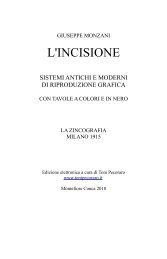TONI PECORARO Bibliography / Bibliografia
TONI PECORARO Bibliography / Bibliografia
TONI PECORARO Bibliography / Bibliografia
You also want an ePaper? Increase the reach of your titles
YUMPU automatically turns print PDFs into web optimized ePapers that Google loves.
Those who are practical of traditional doctrines, know that rational knowledge is a small thing<br />
compared to that intuitive knowledge which springs from the heart.<br />
When Antoine de Saint Exupéry wrote that 'the essential is invisible to the eye' he was expressing in<br />
words what Pecoraro tries to represent in his incisions, thus showing the road he wishes to travel.<br />
It is not by chance that one of his first ex libris, the fifth to be exact, was born as homage to<br />
Michel Butor on his seventieth birthday.<br />
The French writer, who collaborated with such elevated cultural personalities as Heidegger, Magritte,<br />
Bataille, Lévis-Strauss, Klossowski, Evola and others, in the enquiry into the relation between<br />
magic and art organised by André Breton, is, in fact, a careful observer of everything which<br />
can be considered 'extraordinary'.<br />
Butor wrote that: " If and insomuch as the modem artist is conscious of aiming at the transformation<br />
of the reality surrounding him (changing life), basing hirnself on laws that he discovers and dark<br />
faces that he perceives by intuition, his behaviour will be parallel to that of the ancient magician ".<br />
In this magic world, of which Pecoraro, too, recognises the importance, the figure of the labyrinth<br />
assumes a paradigmatic significance.<br />
Because the labyrinth, traditional representation of those ordeals which only the initiated can endure,<br />
and maybe, conquer, recurs with significant frequence in his works. It is not by chance that bis<br />
free graphic arts on this subject have been quoted and reproduced in the brilliant international magazine<br />
"Grapheion" .<br />
In the labyrinth Pecoraro sees the false, twisting way that leads to the place where initiation is<br />
fulfilled, the impalpable and tenuous space in which man may be reunited with the earth and the<br />
gods. We find continual references to this earth, the magic door that not all may approach, in every<br />
one of his works. Whether it is represented in a poetically naturalistic way or transformed by a<br />
knowing play of lines and planes which are only apparently unreal, it is always Sicily that Pecoraro<br />
recognises as the place where 'being sacred ' is possible.<br />
The artist allows us to identify geographically the place to which the journey inside the labyrinth<br />
inevitably seems to lead us , but he tells us nothing of the other dimensions.<br />
The references to historic reality are impalpable: persons and things remain frozen and out of Time,<br />
like fragile archetypes whose language can be understood only by the few.<br />
The labyrinth of the ex libris in the name of Marco Fragonara, work with which the artist has<br />
recently won first prize in the international competition ' St. George in the ex libris ', assumes,<br />
however, another meaning.<br />
Like all symbols, not even the labyrinth has a unique interpretation. It is here, then, that the labyrinth<br />
becomes a dragon, a terrible, aggressive monster before whieh man (St.George) is alone and<br />
naked: revelation of a knowledge that is not for all, but also warning not to overthrow that natural<br />
order whieh maintains the balance and harmony of all things.<br />
In answer to Breton's enquiry into art and magic, Valentin Bresle wrote: ' No work can be<br />
12









